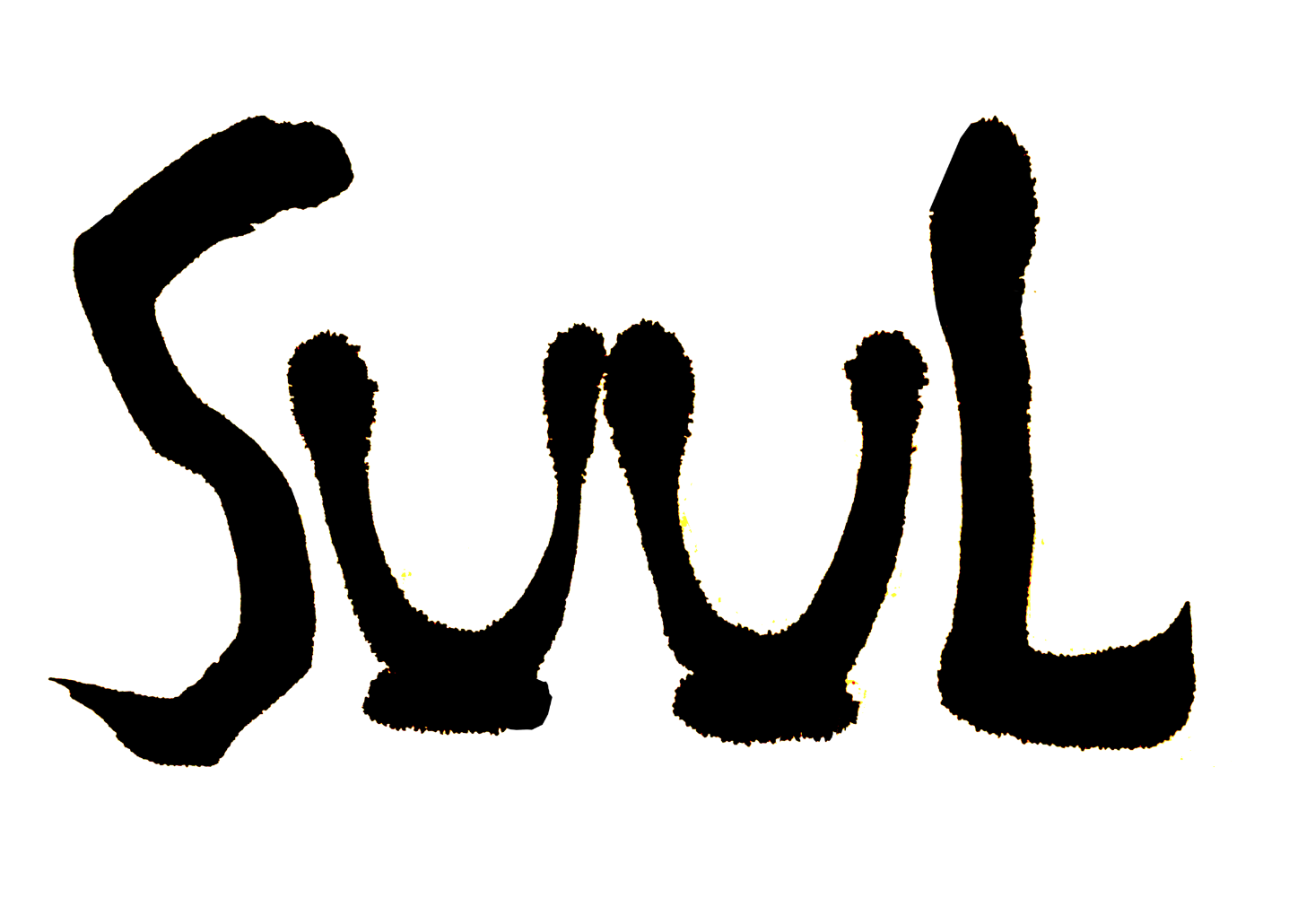한국에서 술을 의미하는 어휘인 ‘술[sul]’은 어원이 명확하지 않다. 그러나 오랜 세월 일상에서 사용되어 왔다. 한국의 전통 술은 특정한 주종(酒種)을 나타내는 여러 이름이 있다. 청주, 탁주, 동동주, 막걸리, 소주 등이 그것이다. 이들은 술을 의미하는 한자어 ‘酒[jiǔ]’ 앞에 술의 양태나 성상을 설명하는 어휘를 결합시킨 이름이다. 예를 들어, 청주는 ‘맑다’는 의미의 한자어 ‘淸’을, 탁주는 ‘흐리다’는 뜻의 한자어 ‘濁’을 역시 ‘酒’와 결합시킨 형태이다. 또한 소주에서 ‘燒’는 ‘불사르다’는 뜻으로써 증류한 술을 의미한다.
일본어에서 술을 의미하는 ‘さけ[sake]’는 한자어 ‘酒[jiǔ]’를 훈독(訓讀)한 경우이다. 한국어 ‘술’이 한자어 ‘酒’에 대응하는 것에서 보듯, 한국어에서 알코올음료, 즉 술을 총칭하는 어휘를 선정한다면 바로 ‘술’이라는 단어로 자연스럽게 귀결된다.
20세기 초, 육당 최남선(1890-1957)은 조선상식문답(朝鮮常識問答)에서 "술을 의미하는 어휘에 고대 융가르와 마갸르의 ‘Ser’와 달단語의 ‘Sra’가 있다."는 기술을 한 바 있다. 또한 육당이 함께 언급한 술을 의미하는 범어(梵語)의 ‘Sura’는 인도에서 여전히 사용되고 있다. 이는 학계에서 현재 새롭게 조명 중인 내용들로써 한국어 ‘술[sul]’은 인도와 어떤 연결점이 있을 법도 해 보인다. ‘술’의 어원에 관한 또 다른 여러 조명이 있을 터이나, 이 글에서는 언어학이나 인류학적 측면의 고찰은 내려놓고 오로지 한국어 ‘술’을 영어로 어떻게 자리매김 할 것인가에 초점을 맞추고자 한다.
‘술’은 영어로 ‘Sool’이나 ‘Suul’로 표기할 수 있다. 그러나 브랜딩이라는 측면에서 본다면 후자가 브랜드의 이름으로 쓰기에는 더 적합해 보인다. 4개의 알파벳으로 구성된 것으로써 ‘sool’처럼 꼬리가 ‘ool’로 이루어진 영어 단어에는 ‘fool’을 포함하여 ‘wool’, ‘tool’, ‘pool’ 그리고 ‘stool’이 있다. 이들은 매우 심플한 구성으로써 직선적이기까지 한 느낌을 주어 신비감을 형성할 공간이 전혀 보이지 않는다. 그렇다면 후미가 ‘uul’로 이어지는 영어단어에는 무엇이 있을는지 하지만 그것은 아무 데도 없다. 이렇게 새로이 채용된 어휘로 만들어진 ‘Suul’은 신비감을 주기에는 더할 나위 없는 적합한 요소를 갖게 된다.
질문을 하나 던져보자. ‘청주, 막걸리, 소주는?’, ‘과연 어떻게 이름을 지을 수 있을지?’ 이에 대하여는 한국 안에서 볼 때, 특별히 이름을 바꾸거나 할 이유가 없었다. 간단히 말하자면 오랜 세월에 기인한 까닭에 가능한 일도 아니었다. 그러나 새로운 시장에 나설 때는 복합적인 범주의 여러 이름들을 동시다발적으로 내세우기 보다는 단일한 이름 하나만을 내세운 편이 훨씬 현명한 선택이다. 즉, ‘술’이라는 이름이 글로벌 시장에서 한국의 술로 알려지고 기억되려 하는 시점에 있어, 또 다른 이름을 가진 한국 술이 나타나는 상황이 되는 것이다.
한국 술을 모두 총칭하는 하나의 종(種)으로서 ‘술’이라는 어휘를 뒷받침하려면 마케팅의 차원에서 세 가지의 하위 군(群)으로 나누어야 한다. 즉, 막걸리는 ‘Unfiltered Korean Suul’로, 청주는 ‘Filtered Korean Suul’로, 소주는 ‘Distilled Korean Suul’이 되는 것이다. 이렇게 술을 그 주종에 따라 평이한 영어로 설명해주면서 동시에 뒤에 ‘Suul’을 수반하게 하면, 산재한 하위 개념의 이름에서 비롯되는 혼동을 최소한으로 줄여줄 것으로 보인다. 실인즉, 청주, 막걸리, 소주는 보드카, 럼, 데킬라, 위스키, 사케, 13
화이트 와인, 레드 와인과 마찬가지로 술의 하위 범주에 속하는 이름들이다.
(중략)
이제 술에 대한 브랜딩을 마쳤다면 이것이 일반적으로 인식되어지게끔 할 필요가 있다. 와인의 관행을 생각해보면 청주의 이름도 원재료인 쌀의 이름뿐만 아니라 생산지의 명칭을 붙여 고유한 특성에서 우러나오는 나만의 독특한 이름을 지어볼 수 있다. 이에 대하여는 몇 가지 사례와 가설을 제시하면서 다음 절에서 다루기로 한다.
This wordmark was created by Sunook Park to symbolize Suul. The Brewery Los Angeles, 2017.
Though its origin is unclear, the Korean word ‘술[sul]’ is a general term for all Korean alcoholic beverages, and it has been commonly used in everyday language in Korea for a very long time. There are other words that describe specific types of traditional Korean alcoholic beverages, such as Yakju, Takju, Dongdongju, Makgeolli, Soju, etc. Many of these names are descriptive, combining a prefix that explains the condition of a certain beverage with the word '주'(Ju), which comes from the Chinese character '酒'[jiǔ] for alcoholic beverage: Cheongju(清酒) means ‘clear’ Suul, Takju(濁酒) means ‘cloudy’ Suul and Soju(燒酎) means ‘burned’ or ‘distilled’ Suul.
In Japan, the word 'さけ'(Sake), or alcohol in Japanese, is a translation of the Chinese character '酒'(Jiu). Since 술(Suul) in Korean is equivalent to 酒(Jiu), it seems only natural for the word Suul to act as a general term for alcohol, encompassing all Korean alcoholic beverages.
The famous 20th century Korean scholar Choi Nam Sun(1890-1957) wrote in his book, Chosun Sang Shic Mun Dap, "One of the old ethnic groups named Tatar, Jungar & Magyar used ‘Sra’, ‘Ser’ when they referred to the alcoholic beverages." ‘Sura’ originates from the Sanskrit alphabet, and is still used as the word that denotes alcohol in Hindi. Though it challenges the currently dominant academic theory, it seems that the Korean word 술(Suul) may have some connection with the Hindi language. There are other theories about the origin of the word 술(Suul), but in this paper, we shall leave the in-depth study of its etymology to linguistic and cultural anthropological researchers, and instead focus on the transcription of 술(Suul) in English.
술 can be romanized either as ‘Sool’ or ‘Suul.’ Through a branding perspective, the latter is more appropriate for a brand name. There are few other four-letter words in English ending with ‘ool’, including ‘fool'. The others, ‘wool’, ‘tool’, ‘pool’, or ‘stool’, are all very simple and straightforward, leaving no room for a sense of mystery or intrigue. Meanwhile, what English words end in ‘uul'? There are none. And so, the distinctive character of ‘Suul’ makes it much more suited for entry into the English-speaking world. Furthermore, Suul is typographically more dynamic in form. The double ‘u’ in the middle looks like cups for two to share a drink of Suul in. This would give the name enormous marketing and advertising potential.
One might raise the question, ‘What about Cheongju, Makgeolli and Soju? How could we name those?’ There is no reason to actively erase those names, and it would simply not be possible due to their long held household existence in Korea. But it would be wise to propose a singular new name to the market rather than try to raise awareness for multiple names all at once. Once Suul is known and remembered in the global market as representative of all Korean alcoholic beverages, the other names will surely follow.
The idea of marketing Suul as the general category name for Korean Suul relies on three descriptive names in English to clarify the three basic subcategories: Unfiltered Korean Suul (Makgeolli), Suul (Cheongju) and Distilled Korean Suul (Soju). By using these subcategory names with plain English descriptors containing the word Suul, there will be minimal confusion in understanding the structure of Korean Suul. In truth, Cheongju, Makgeolli and Soju are still more accurate descriptors, carrying all the same uniqueness of vodka, rum, tequila, whiskey, sake, white wine or red wine.
(Omitted)
Eventually, the actual branding of individual Suul types within each product category will be necessary once the general awareness of Suul is established. If Suul follows the same naming conventions of wine, we may name brews of Cheongju or Soju using the name of the rice used to produce it and the region where it was produced, along with its unique brand name. In later pages, I have illustrated a few branding case studies using this same hypothesis.

